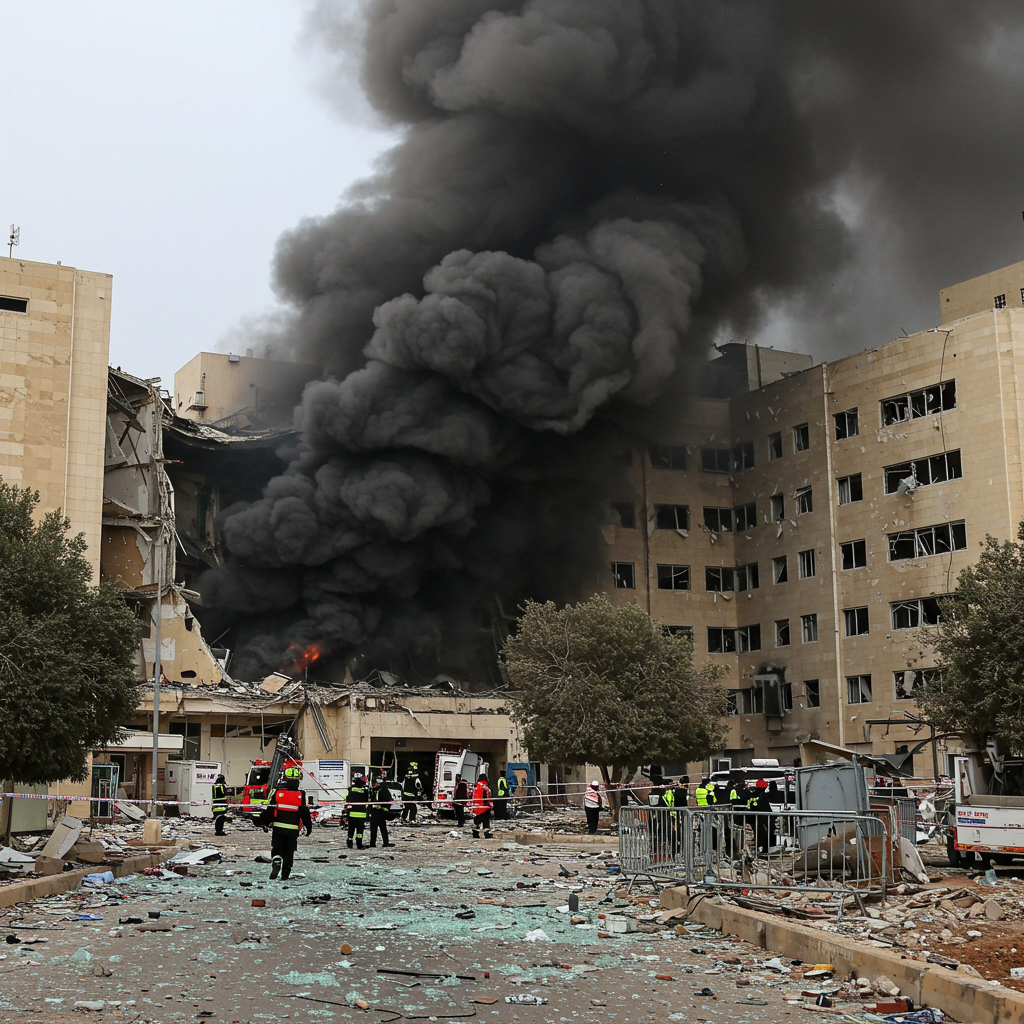In a dramatic escalation of the ongoing conflict between Israel and Iran, the United States has launched extensive military strikes against three key Iranian nuclear facilities. President Donald Trump announced the attacks, which he described as “very successful,” targeting sites in Fordow, Natanz, and Isfahan.
The precision strikes mark a significant turning point, directly involving the U.S. in the hostilities that have seen weeks of aerial exchanges and casualties on both sides.
Operation Midnight Hammer: The US Military Action
The large-scale operation, codenamed “Operation Midnight Hammer,” was conducted on a Saturday, reportedly involving around 125 U.S. military aircraft and expending 75 precision-guided munitions. A core component of the attack involved seven B-2 Spirit stealth bombers flying an 18-hour mission from the United States. These bombers were crucial for delivering the GBU-57 Massive Ordnance Penetrators (MOPs), also known as “bunker-buster” bombs.
A total of 14 MOPs were dropped on two target areas, including the Fordow facility, which is located deep underground within a remote mountain. This marked the first-ever operational use of the 30,000-pound MOP weapon, designed specifically to penetrate deeply buried hardened targets like Fordow, a capability beyond Israel’s military alone. The Natanz site also received MOPs. Additionally, about two dozen Tomahawk land-attack cruise missiles were fired from a U.S. submarine, targeting the Isfahan facility.
The complex mission involved deception tactics, with some B-2s flying westward as a decoy while the main strike package took an eastward route. Fighter jets, including F-16s and F-35s, provided escort, sweeping for threats and potentially using anti-radiation missiles to suppress Iranian air defenses. U.S. officials stated they did not believe Iranian forces fired upon the U.S. aircraft during the strikes.
Initial battle damage assessments by the Pentagon indicated “extremely severe damage and destruction” at all three sites, though final evaluations were ongoing. President Trump declared Iran’s “key nuclear enrichment facilities have been completely and totally obliterated” and that the Fordow facility was “gone.” However, questions remain regarding the full extent of the damage and whether Iran had successfully moved sensitive materials, such as its stockpile of enriched uranium, to other locations beforehand. Satellite imagery captured after the Fordow strike reportedly showed several new craters consistent with the entry points of penetrator munitions, with evidence suggesting underground detonations and potentially blocked tunnel entrances.
Justification vs. Criticism: Why the Strikes Happened
The U.S. and Israel justified the strikes by stating they were necessary to dismantle Iran’s nuclear program and prevent Tehran from acquiring nuclear weapons, framing it as a response to an imminent threat. This comes despite conflicting assessments from some U.S. intelligence agencies, which reportedly believe Iran is not currently actively pursuing a bomb.
The strikes followed over a week of direct aerial combat initiated by Israel on June 13, which aimed to degrade Iran’s nuclear and military capabilities. U.S. officials acknowledged that Israel’s prior actions “laid much of the groundwork” for the success of the U.S. operation by creating strategic access opportunities.
However, the U.S. intervention drew sharp criticism from various quarters. Trita Parsi, executive vice president of the Quincy Institute for Responsible Statecraft, argued there was “absolutely no evidence” that Iran posed any kind of threat, existential or imminent, to the United States. He highlighted that two nuclear-equipped states (the U.S. and Israel) had attacked a non-nuclear weapons state without being attacked first, noting Israel started the initial conflict and the U.S. initiated this direct confrontation. Parsi predicted that these attacks would inadvertently encourage more countries to seek nuclear deterrence, fearing they could become future targets.
President Trump’s decision also represented a significant shift, contrasting with his earlier foreign policy rhetoric about avoiding costly Middle East wars. Domestically, the strikes sparked debate, particularly among Democrats who criticized the President for launching military action without seeking congressional authorization, alleging he risked dragging the U.S. into a wider war without a clear strategy. Some Republicans also expressed dissent, questioning the constitutional basis for the action.
Iran’s Reaction and International Fallout
Iran reacted swiftly and strongly to the U.S. strikes. Foreign Minister Abbas Araghchi condemned the action as a “grave violation” of the UN Charter, international law, and the Non-Proliferation Treaty (NPT), describing the strikes as “outrageous, lawless and criminal behavior” with “everlasting consequences.” He warned that Iran reserved all options to defend its sovereignty and interests and called for an emergency UN Security Council meeting to hold the U.S. accountable.
Iran’s nuclear agency confirmed its facilities were struck but claimed damage was not major, insisting materials had been evacuated beforehand and that work would continue. They reported field surveys and radiation monitoring systems showed no signs of contamination or danger to residents near the sites. This assessment was corroborated by the UN’s International Atomic Energy Agency (IAEA) and Saudi Arabia, both of whom reported no increase in off-site radiation levels at the affected key nuclear sites following the U.S. strikes.
Despite claims of preparedness, Iran vowed “regrettable responses.” Shortly after the U.S. strikes, Iran reportedly launched a fresh barrage of approximately 30 missiles targeting parts of Tel Aviv and Haifa in Israel, resulting in injuries and damage. Iranian President Masoud Pezeshkian stated the U.S. “must receive a response” while also indicating a readiness for dialogue under international law.
International reaction to the escalation was varied. Israeli Prime Minister Benjamin Netanyahu praised President Trump’s decision as “bold” and history-changing. Conversely, UN Secretary-General Antonio Guterres expressed being “gravely alarmed” by the “dangerous escalation,” warning the conflict could rapidly spiral out of control with “catastrophic consequences for civilians, the region, and the world.” The UK, France, and Germany called for de-escalation while reiterating support for Israel’s security and the need to prevent Iran from acquiring nuclear weapons. Russia strongly condemned the U.S. attacks as an irresponsible violation of international law, while Oman also condemned the strikes and called for de-escalation. India emphasized the need for “dialogue and diplomacy.”
Potential Consequences and Future Outlook
The strikes have undeniably heightened tensions and increased the risk of a wider conflict. The U.S. took precautionary steps to mitigate potential Iranian or proxy retaliation, including moving aircraft and placing troops on heightened alert in the region. U.S. homeland security and intelligence officials described the situation as “uncharted territory” with a “very high” threat level for potential Iranian reprisals, both physical and cyber.
Experts like Trita Parsi suggested that far from halting Iran’s nuclear ambitions, the attacks have “more or less guarantee[d]” that Iran will seek to become a nuclear weapons state within five to ten years, seeing it as the only way to deter future attacks from nuclear powers. Parsi also anticipated that Israeli officials would likely argue the strikes were not fully successful and push for a more sustained bombing campaign against Iran.
The broader conflict between Israel and Iran has already resulted in significant casualties. Iranian state media reported at least 430 killed and 3,500 injured in Iran since Israel’s initial attacks. Israeli authorities reported 24 civilians killed by Iranian missile attacks and nearly 1,300 injured, with over 450 Iranian missiles reportedly fired towards Israel.
President Trump’s post-strike warnings to Iran offered a stark choice: “There will either be peace or there will be tragedy for Iran.” He added that many other targets remained ready to be struck quickly if peace did not come swiftly. While U.S. officials indicated they reached out to Iran diplomatically after the strikes to clarify these were the only planned actions and regime change was not the goal, the uncertainty surrounding the damage assessment, Iran’s vowed response, and the broader regional dynamics leave the future trajectory of the conflict highly uncertain.


